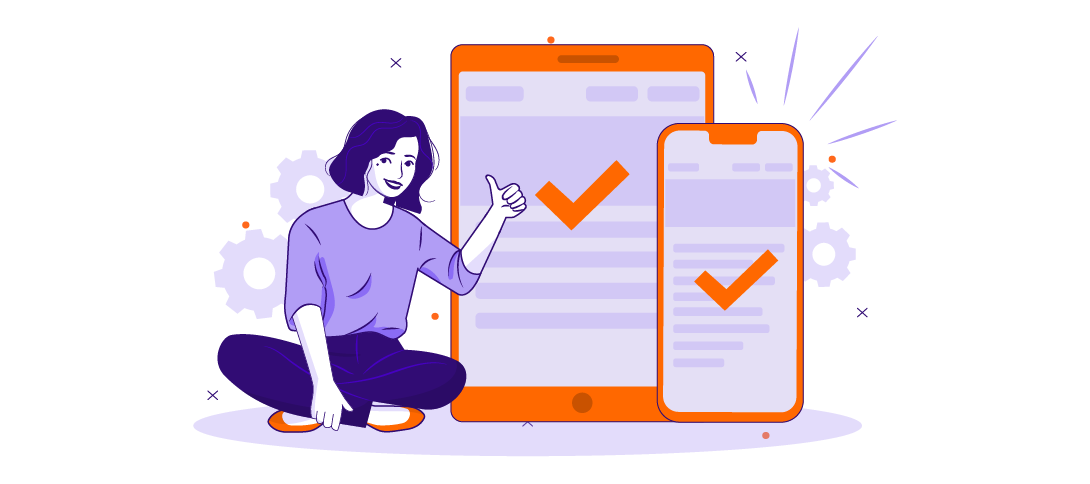
What is Mobile Learning
(M-Learning)?: Benefits & Tips

With the advent of technology, mobile learning (M-learning) is now second nature for most tech-savvy people.
It’s second nature because most people use their mobile devices for just about everything.
If you don’t know something, what’s the first thing you do to access that information?
If you said, “Google it,” you’d be correct!!
Mobile phones are now the center of our universe, and we use them for everything, including communicating with friends and family, ordering food, playing games, online shopping, and just about everything under the sun.
With this behavior already hardwired into our brains, we can now make use of mobile learning by leveling up and acquiring new skills using a learning process that involves using mobile devices.
In this post, we’re going to go over how to do just that by discussing how to use mobile learning environments to enhance e-learning and higher education, as well as the advantages and disadvantages.
Ready to start learning?
Let’s do it!
What is Mobile Learning?
Before we dive in, let’s discuss exactly what mobile learning is by providing a definition.
Simply put:
Mobile learning, also known as m-learning, is acquiring knowledge by educating oneself using mobile technology.
This allows the learners and students to have complete flexibility by having the ability to conduct research or access a learning environment using mobile devices whenever or wherever they want.

Key Components of M-Learning in Education
In today’s day and age, it has become the norm for people to access the internet using a smartphone or mobile device in conjunction with multiple other devices such as laptops, tablets, and desktop computers.
In fact, it’s precisely what Google uses to index and rank websites. The priority is placed on the mobile version.
It is this ability to access learning management systems from anywhere that has made m-learning experiences just as popular among students in the classroom as it is for corporate training & education for employees.
Let’s go over some key components of this new wave of online learning.
Microlearning Content
Microlearning content allows learners to understand the content on a deeper level by providing engaging content delivered in short form. Typically under 10 minutes at a time. This allows for training modules to break down processes into bite-sized chunks to improve knowledge retention for learners.
By embedding microlearning into your mobile learning experiences, you’re repeating natural behavioral processes that we use daily, from social media feeds, short-form videos, animation, gamification, quizzes, and other interactivity that will increase retention and hold a learner’s attention.
Social Communities
One of the best components of mobile learning is for students to enhance their educational journey by making use of social learning that makes use of online communication through communities.
For example, in the contexts of the online classroom, you can enhance your learners’ training via chat, forums, social media, text messages, and other training methods used with mobile technology. Some companies even opt to develop mobile apps to streamline accessibility.
The process of teaching and learning through online social communities will only continue to evolve as mobile learning becomes more prevalent.
Ease of Access
Accessibility is the main component that drives mobile learning because it’s what makes m-learning possible for students and employees through the use of a mobile device.
Incorporating seamless access without complications, such as logging in or having multiple steps in place, to gain entry to resources and course content is imperative for teachers, college students, and employees conducting corporate training remotely.
Easy access is such a crucial component for corporate employees since they are always on the go and the vast majority of them work remotely. It allows them to conduct training sessions in minutes using their mobile devices in their own time.
The same can be said for student learning in today’s society.
Interactivity & Scenario-Based Learning
Making content interactive by providing roleplays and scenario-based learning is useful for engagement and knowledge retention.
Gone are the days of passive learning through boring and mundane course content. It’s important to capture the attention of your learners by actively engaging them and getting them involved in their digital learning.
What type of interaction?
We touched on this a bit already, but here are some ideas:
Blended Learning
Surveys
Choose Your Own Adventure
Roleplays
Scenario-Based Learning
Video Animation
Gamification
Plus More
This helps to support the development of mobile learning by providing real-time course content that’s entertaining and highly engaging.
Not only do learners benefit from the key concepts of m-learning, but teachers, corporate trainers, and university professors all get to reap the benefits of mobile learning from anywhere they can access the internet.
Let’s discuss the advantages; keep reading!
Advantages of Mobile Learning
Mobile learning is constantly evolving, and the eLearning industry is always finding new ways to improve the training experience for corporations, employees, companies, teachers, and students with innovative learning tools.
Here are just a few advantages of this new training and teaching methodology for the digital age.
Increases Employee Retention
One major advantage of making use of employee training via mobile devices is the fact that it increases employee retention.
Why is this important? Two reasons:
It reduces employee turnover
It increases motivation
If you think about the cost associated with finding good talent, like recruiting, interviewing, training, employee onboarding, and more, you’ll realize that it’s not cheap. In fact, according to Business News Daily, it costs about $4000 per employee on average.
The data on mobile learning is clear. Mobile learning boosts employee retention allowing for highly trained and happy employees.
Our findings also indicate that mobile learning helps with employee motivation.
How so? 94% of employees have stated that they would stay longer at a company that invests in their learning and development (L&D). Having resources that offer professional and personal support that can help them upskill their knowledge is a win-win.
Students and learners increase their value, and your organization provides the tools and becomes more efficient.
Encourages Continuous Training
Embedding teacher-led learning modules into your workforce culture makes it easier for employees to get related training from any device.
This is as opposed to in-person training and other formal resources a company might offer to further professional development. Having a self-taught method of training using mobile phones allows students to access course content anytime and anywhere.
This helps to create a positive feedback loop and gives busy employees the freedom to use mobile learning platforms remotely wherever they have internet access.
The bottom line: Making mLearning as easy as possible for students to develop themselves professionally adds value and encourages continuous training resulting in a highly skilled and motivated workforce.
Ease of Use
Accessibility is an excellent advantage for employees using your mobile learning platform for training. This is especially true for a remote workforce.
With people dispersed all over, it’s important to deliver 24/7 access to training for students or employees from whatever device they predominantly use.
If you want to make it even easier, you can create a mobile app that allows them to stay logged in and removes the need for login details.
The key is to remove any barriers or limitations and allow for easy access to training.
Cost-Effective
One benefit of switching to mobile learning as opposed to in-person classroom training is that it’s cost-effective. This is simply because the costs associated with in-person training require lots of resources.
For example, businesses investing in their live training program will need the following:
A trained instructor
Training materials
Equipment & technology
Food & travel expenses
Not to mention the amount of productivity lost due to time in the classroom.
Having students use a mobile device to access learning materials hosted on the internet from anywhere adds up to quite a bit of savings. Both in time and money.
Entertaining & Engaging Content
One of the main reasons to delve into mobile learning is that it helps with knowledge retention. This has a lot to do with eliminating boring content like text and other related learning materials that lose an employee’s attention.
Exchanging this outdated training method for a new and improved learning platform allows for the ability to create entertaining and engaging content that gets students involved in their development.
Instant Feedback
Having the ability to train online from anywhere also increases the completion rates and speeds up the results. This form of training helps to facilitate instant feedback so that employees can know where they stand and work to improve or correct any shortcomings in real time.

Disadvantages of Mobile Learning
Now that you know some of the advantages of mobile learning, let’s explore some of the disadvantages.
Distraction & Interruption
When you bring mobile devices into the learning space, it can create distractions or interruptions in the way of text messages, notifications, social media, and other disruptions. This can cause an intrusion to productivity which is why it’s important to create highly engaging and entertaining learning materials.
Implementing interactivity and fun into the learning process renders any other distractions useless. Of course, having a bit of self-discipline and willpower also comes in handy.
Technical Difficulties
One disadvantage of mLearning could be internet connectivity problems or limited access to technology. Fortunately, this should be a thing of the past, especially since there are now more smartphones in the world than there are humans, according to a report by Quartz.
Despite this fact, you should try to think logically about how your teams are set up, what tech they have access to, and which type of training will most move the needle forward for your business.
It may make sense to save time and money by investing in the right technology to support your business needs.
Lack of eLearning Knowledge
Examples of Mobile Learning Technology
To give you an idea of what can come of investing in a good mobile learning platform, let’s look at some examples of what’s possible using mobile learning technology.
Here are three examples that stand out:
1. Duolingo
Duolingo is a language-learning platform that has made use of gamification and microlearning to be at the forefront of e-learning for any device. It’s now the most downloaded education app on the planet.
2. TED-ed
Ted-ed is an educational platform that is related to TED which stands for technology, education, and design. They’ve built an interactive learning platform using video that encourages learners to answer questions and discuss what they’ve learned.
3. Udemy
Udemy is another eLearning platform that has created a crowd-sourced catalog of courses led by expert instructors from all over the world. The reviews from other students and video commercials for each course allows users to decide if the content is right for them. You can learn just about any subject on Udemy these days.
M-Learning Final Thoughts
So there you have it!
In this article, we’ve gone over what mobile learning is, the advantages & disadvantages, as well as a few m-learning examples. Now the ball is in your court!
What will you do next to provide next-level training for your organization that can be accessed from anywhere? For more information about video eLearning, check out the Ninja Tropic blog, or contact us for some assistance with your mobile learning program!
